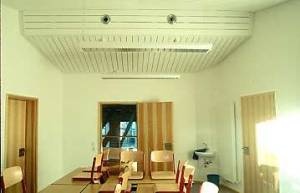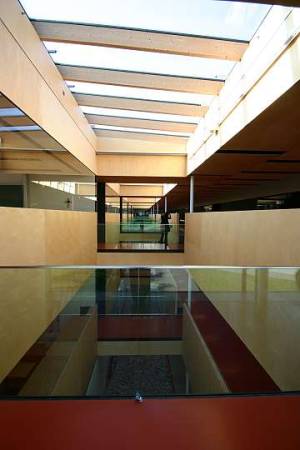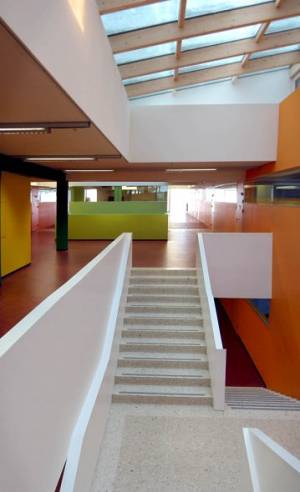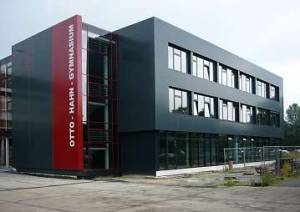Table of Contents
Passive House Schools - Boundary Conditions
Research for building Passive House schools has been conducted in the Research Group for Cost-effective Passive Houses Vol. 33
1. Each modern school should have controlled ventilation which meets the criteria for acceptable indoor air quality.
This was shown in a contribution by Rainer Pfluger in the relevant Protocol Volume [AkkP 33] .This is nothing new; these findings had often been made during measurements of the air quality in schools, but were repeatedly ignored. In the long term however, one can't get around this fact. In 2020 this became appearent again with the COVID-19-pandemic: The virus floats for quite a time (up to 3 hours) in the air. The infection risk is higher, the higher the concentration. Therefor, providing a decent amount of fresh air (which is around some 15 to 30 m³/h per person in schools depending on the age) will dilute the aerosol particles and reduce the infection risk. If you calculate the fresh air requirement in a classroom, you will often end up with 3 ore even more airchanges per hour; this is difficult to provide, unless you keep windows fully open or you have a working mechanical fresh air supply. The first alternative is not realistic in typical Central European winter condition. It is the second path to go - and that will also reduce all the other indoor air pullutants to secure levels (for example the particulate matter).
2. In the interest of a justified investment or technical expenditure, the air flow rates of the school's ventilation system should be based on health and educational objectives and not on the upper limits of the comfort criteria. The result is: CO2 limit values between 1200 and 1500 ppm and designed air flow rates between 15 and 20 m³/person/h (possibly more for a higher average age of the pupils).
With these reference values, the result is a significant improvement in the air quality in comparison with the values usually obtained in Germany, Austria and Switzerland today. Experience with the Passive Houses already built also shows that the designed values should not be reduced even further. For increased air quantities attention would have to be paid to the resulting reduction in the relative air humidity in winter, however – this raises a number of questions (hygiene of any possible moisture recovery or supply air humidification, more equipment for corresponding air conditioning systems), which were not dealt with in the Research Group. If the per person air flow rates are projected as 15 to 20 m³/(h pers) in the given interval, the primary objectives of indoor air quality will certainly be achieved and the problem of low relative humidity does not even arise.
If we go for even higher fresh air flows, what is desirable in case of infection risks, we will have to take care for keeping the indoor relative humidity above ~30%. An air humidifier will have to be used if external temperatures are low (lower than ~14°C). It is important in this case that the humidifier is kept clean all the time.
In comparison with residential buildings and office buildings, the overall air flow rates and air change rates which have to be planned are considerably higher during use due to the increased number of persons present in schools.
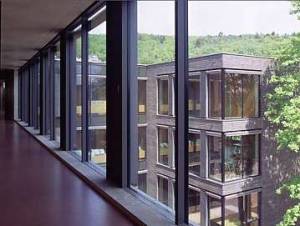
3. In the interest of justifiable operational costs, the ventilation systems in schools must be operated periodically or according to demand. Preliminary purge phases or subsequent purging periods ensue before and after use for hygiene reasons. The easiest solution is to use time control.
A direct result of the designed high air change rates is that the operating times of the ventilation system have to be restricted to the periods of use or the air quantities should at least be greatly reduced outside of these times, because otherwise there will be very high electricity consumption values even for efficient systems – this differs fundamentally from home ventilation in which the designed air quantities are near those required for basic ventilation needed on a permanent basis (with 0.25 h-1).
In schools, for basic ventilation planned with 2 h-1 or even more, there are several possibilities, the most efficient being a one-hour preliminary purge phase with designed volumetric air flows, with which the necessary ”double” exchange of the air volume can be achieved. After that, regulation of the air quantities according to demand should be strived for, on which the occupancy density, the CO2 content of the air or other representative air quality indicator can be based.
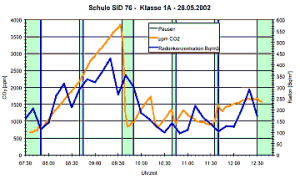
As shown by experience, it should be ensured that the technology used is robust and simple and, if necessary, possible to operate manually (no “technological Christmas trees”). For intermittent operation of the ventilation system, it is important that all system parts, especially the filters, are “run dry” before switching off the air flows – this is achieved most easily by using the recirculation mode after the period of use.
4. Passive House schools should be designed so that besides the usual heating using supply air, it is also possible to heat up the rooms to a comfortable level during the preliminary purge phase in the morning.
In [AkkP 33] is stated that heating classrooms using the supply air in schools is no problem because the volumetric fresh air flow based on the useable area is very high. However, after the setback phase, reheating to a comfortable level (particularly in relation to the radiation temperature asymmetry) is only possible if the building's envelope surfaces have a high level of thermal protection. For schools this is the decisive criterion.
Parametric studies with thermal simulation of school buildings show that under the given conditions the level of thermal protection complying with the “residential Passive House Standard” is within the range of optimum results. Nevertheless, for school buildings there is more scope than there is for residential buildings, due to the many kinds of regulation possibilities and the high air changes available. Because the buildings are generally comparatively large and compact, the designer is well-advised to approach the optimum level by complying with the classic Passive House Standard while at the same keeping a safety margin.
5. The criteria given above can be met if, under the boundary conditions of use, the building envelope and heat recovery are designed so that the annual heating demand according to the PHPP is less than or equal to 15 kWh/(m²a) (based on the total net useable area).
A detailed analysis has confirmed the planning guidelines according to which some Passive House schools had already been planned and built. This was by no means self-evident, as, due to the completely different usage, this criterion is derived in a completely different way than the criterion which applies to residential buildings.
Nevertheless, it is no coincident that this result is quantitatively comparable with that of the Passive House residential building; the reason for this is that the temporal average values of the boundary conditions (air quantities, internal heat sources, heat load) are very similar to those for residential use.
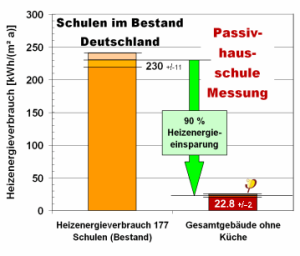
See also: Passivhaus-Schule Riedberg (Frankfurt/M)
6. Secondary conditions:
a) In order to avoid temperature asymmetry, a window U–value of less than or equal to 0.85 W/(m²K) including installation thermal bridges is also recommended for windows in Passive House schools.
b) The building envelope must be built in a very airtight way. n50 < 0.6 h-1 is required and < 0.3 is recommended.
The secondary condition a) only needs to be fulfilled if the window has neither a parapet (> 0.65 m) nor a source of heating under it. Nevertheless, it won't be easy to achieve the Passive House Standard with windows having significantly higher U-values.
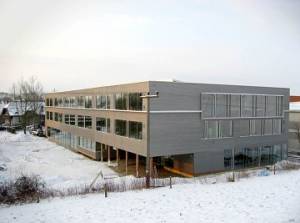
7. The annual primary energy demand for all non-renewable energy supplied to the school building should be less than or equal to 120 kWh/(m²a) according to the PHPP (based on the total net useable area).
In order to exclude inefficient supply systems, the primary energy criterion should also be met for Passive House schools. In doing so, it should be noted that according to the PHPP, not all renewable energy supplied across the boundary of the premises contribute to the primary energy consumption (i.e. including lighting and if applicable, electronic systems).
8. In order to ensure comfort in summer in a Passive House school, the frequency of temperatures over 25°C should be limited to less than 10% of the hours of use.
Due to the extremely high temporary internal loads in school buildings, particular attention should be paid to comfort in summer. Sufficient night-time ventilation during hot spells (ventilation systems with efficient summer bypass are suitable for this, but free ventilation is also possible) and effective shading of the glazing is indispensable.
9. The total effective area-specific heat capacity of the space-enclosing components should be cwirk >150 Wh/(m²K) { 540 kJ/(m²K) } (based on the base area of the classroom). Alternatively, additional cooling facilities must be provided (besides night-time ventilation and shading).
Simulations in [AkkP 33] have shown that the provision of a sufficiently greater internal heat capacity is an easier method of ensuring comfort in summer with less effort.
The recommendation is met by the use of solid building components for the internal structures of the building, for example. In unfavourable climates it can also become necessary to take further measures for adequate summer comfort. Using air heaters for cooling by leading the coils through a ground cycle is a simple and efficient method for cooling Passive House schools.
Literature
[AkkP 17] Dimensionierung von Lüftungsanlagen in Passivhäusern, Protokollband Nr. 17 des Arbeitskreises kostengünstige Passivhäuser Phase II; Passivhaus Institut; Darmstadt 1999.
(Dimensioning Ventilation Systems in Passive Houses, Protocol Volume No. 17 of the Research Group for Cost-efficient Passive Houses Phase II, Passive House Institute, Darmstadt 1999)
[AkkP 23] Einfluss der Lüftungsstrategie auf die Schadstoffkonzentration und -ausbreitung im Raum, Protokollband Nr. 23 des Arbeitskreises kostengünstige Passivhäuser Phase III, Passivhaus Institut, Darmstadt 2003.
(Influence of the ventilation strategy on pollutant concentration and distribution in rooms, Protocol Volume No. 23 of the Research Group for Cost-efficient Passive Houses Phase III, Passive House Institute, Darmstadt 2003)
[AkkP 25] Temperaturdifferenzierung in der Wohnung, Protokollband Nr. 25 Arbeitskreis kostengünstige Passivhäuser; Passivhaus Institut, 1. Auflage, Darmstadt 2004.
(Temperature differentiation in the home, Protocol Volume No. 25 of the Research Group for Cost-efficient Passive Houses, Passive House Institute,1st edition, Darmstadt 2004)
[AkkP 30] Lüftung bei Bestandssanierung: Lösungsvarianten, Protokollband Nr. 30 des Arbeitskreises kostengünstige Passivhäuser Phase III, Passivhaus Institut, Darmstadt 2004.
(Ventilation in refurbishment of existing buildings,Protocol Volume No. 30 of the Research Group for Cost-efficient Passive Houses Phase III, Passive House Institute, Darmstadt 2004)
[AkkP 33] Passivhaus-Schulen, Protokollband Nr. 33 des Arbeitskreises kostengünstige Passivhäuser Phase III, Passivhaus Institut, Darmstadt 2006.
(Passive House Schools, Protocol Volume No. 33 of the Research Group for Cost-efficient Passive Houses Phase III, Passive House Institute, Darmstadt 2006)
[Bretzke 2005] Bretzke, A.: Planung und Bau der Passivhaus Grundschule Kalbacher Höhe 15, Frankfurt am Main, 2005: PDF (in German).
(Planning and construction of the Passive House primary school in Kalbacher Höhe 15, Frankfurt am Main, 2005)
[Peper 2007] Søren Peper, Oliver Kah, Rainer Pfluger, Jürgen Schnieders: Passivhausschule Frankfurt Riedberg Messtechnische Untersuchung und Analyse, 1. Auflage, Passivhaus Institut, 2007. PDF (in German) to download it free.
(Passive House School in Frankfurt Riedberg – Metrological Survey and Analysis, 1st edition, Passive House Institute, Darmstadt 2007)
[PHPP 2007] Feist, W.; Pfluger, R.; Kaufmann, B.; Schnieders, J.; Kah, O.: Passivhaus Projektierungs Paket 2007, Passivhaus Institut Darmstadt, 2007.
(Passive House Planning Package 2007, Passive House Institute, Darmstadt 2007), see page PHPP – Passive House Planning Package
See also
Overview of built examples for Passive House schools on Passipedia
More built Passive House schools can be found on www.passivehouse-database.org
Overview of all articles on Passipedia about Passive House schools
Overview of all articles on Passipedia about non-residential Passive House buildings

